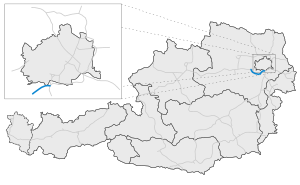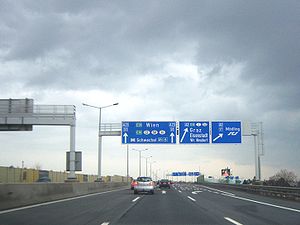Vienna outer ring motorway
| A21 motorway in Austria | |||||||||||||||||||||||||||||||||||||||||||||||||||||||||||||||||||
| Vienna outer ring motorway | |||||||||||||||||||||||||||||||||||||||||||||||||||||||||||||||||||

|
|||||||||||||||||||||||||||||||||||||||||||||||||||||||||||||||||||
| |
|||||||||||||||||||||||||||||||||||||||||||||||||||||||||||||||||||
| map | |||||||||||||||||||||||||||||||||||||||||||||||||||||||||||||||||||
| Basic data | |||||||||||||||||||||||||||||||||||||||||||||||||||||||||||||||||||
| Operator: |
|
||||||||||||||||||||||||||||||||||||||||||||||||||||||||||||||||||
| Overall length: | 38.2 km | ||||||||||||||||||||||||||||||||||||||||||||||||||||||||||||||||||
|
State : |
|||||||||||||||||||||||||||||||||||||||||||||||||||||||||||||||||||
| A 21 at the Vösendorf junction | |||||||||||||||||||||||||||||||||||||||||||||||||||||||||||||||||||
|
Course of the road
|
|||||||||||||||||||||||||||||||||||||||||||||||||||||||||||||||||||
The Vienna outer ring motorway A 21 (coll. Also Allander motorway ) is a motorway in Austria and part of Europastraße 60 . It connects the A 1 west autobahn at the Steinhäusl junction with the A 2 south autobahn at the Vösendorf junction where it joins the Vienna outer ring expressway S 1.
The Vienna outer ring motorway will form part of the so-called regional ring around Vienna in connection with other expressways and motorways .
execution
The A 21 has six lanes between the Vösendorf and Brunn am Gebirge junction . The further route to the Steinhäusl junction is basically four lanes, but there is an additional slow lane in each uphill section .
The two sections of the A 21 at Steinhäusl and Gießhübl are among the steepest sections of the Austrian motorway network with a maximum of 5.2%. So must several times a year, when falls in eastern Austria Snow, snow chains for trucks are imposed or disabled for this completely.
history

The Vienna outer ring motorway was planned back in the 1930s. The construction of the valley crossings began in 1940 (see Alland's history ). For example, barracks were set up in Weissenbach or Sittendorf , which initially housed regular construction workers, but later served as accommodation for prisoners of war . Originally, relatively well-paid workers from Vienna, Burgenland, but also from Germany were housed in the Sittendorfer camp. In September 1941 Ukrainians came to this camp and were trained as soldiers. But later prisoners from France and later Serbia came to the camp. The camp accommodated up to 250 inmates. Typhus broke out in 1942 and claimed numerous victims. After the barracks served as a warehouse for aircraft parts from the sea grotto for a short time , they were shut down like the entire construction sites during the chaos of war. There was also a camp at the Fischerwiese in Klausen-Leopoldsdorf , where Roma were also imprisoned who had to work as forced laborers on the motorway. A barracks camp was also built in Sittendorf in 1938, which originally served the workers and later French prisoners of war as well as Serbian forced laborers. Today a memorial plaque commemorates the barrack camp as well as the Sittendorfer cemetery.
After the war, the plots of land that had already been exchanged or redeemed fell into Soviet hands as German property and only came back into possession of the Republic of Austria after the State Treaty in 1955.
Other route variants were also considered before the construction was continued. One variant was to let the A 21 run south from Alland. But since the Helenental , a narrow valley, would have suffered too much from the landscape, this variant was dropped again. Only in the area of Heiligenkreuz was the route moved further away from the village so as not to affect the Heiligenkreuz Abbey . In addition, a large part of the land required for the construction had already been replaced. So it was not until 1964 that further construction began.
On the first section, opened in 1962, between the Vösendorf and Brunn am Gebirge junction , only one directional carriageway was available. It was only passable in both directions in 1968. The last sections between Mayerling and Hinterbrühl were completed in 1982. In addition, the motorway should continue to run and then merge into the A 4 at Schwechat . This section was executed in the form of the S 1 opened in 2006 .
Soon after the opening of the continuous motorway, a rest station was to be built at the site of today's Hinterbrühl rest area. After partial resistance from the local population, who feared an impairment of their living space, the plan was dropped and the rest station was built in Alland.
| opening | Route section | length |
|---|---|---|
| December 19, 1962 | ASt Brunn / Gebirge - Vösendorf junction (right RFB ) | 2.116 km |
| April 11, 1968 | ASt Brunn / Gebirge - Vösendorf junction (left RFB) | 2.116 km |
| September 24, 1971 | Steinhäusl - Klausen-Leopoldsdorf node | 13,200 km |
| 7th October 1977 | Klausen-Leopoldsdorf - ASt Mayerling | 4.017 km |
| October 24, 1980 | ASt Hinterbrühl - ASt Brunn / Gebirge | 10.442 km |
| 29th September 1982 | ASt Heiligenkreuz - ASt Hinterbrühl | 3.031 km |
| 29th September 1982 | ASt Mayerling - ASt Heiligenkreuz (left RFB) | 5.437 km |
| October 29, 1982 | ASt Mayerling - ASt Heiligenkreuz (right RFB) | 5.437 km |
Accidents
On the night of February 22, 2010, a German coach drove towards Steinhäusl on a truck driving in front of it. There were six deaths, ten seriously injured and twenty slightly injured. Temperatures around freezing point made it difficult to use the forces on the closed motorway.
Problems
On December 2, 2010, after heavy snowfall, 80 trucks got stuck on the A21 and the entire motorway was closed for five hours. After heavy snowfall, the A 21 at the Steinhäusl junction had to be closed on December 1, 2016, as trucks got stuck there despite winter equipment. One reason was the gradient there of more than 5%. There was another closure on April 19, 2017 after heavy snowfall, as a number of trucks and many cars that were already on summer tires got stuck on the A21 for hours. The Asfinag replied to the criticism of having reacted too late to the snowfall that they had sent the snow plows on street only hours before the onset of the strongest snowfall. Lorries standing sideways and the fact that the emergency lane was not created by drivers would have made it impossible to get through with the snow plows. In a statement dated April 20, 2017, Infrastructure Minister Leichtfried declared that he would extend the winter tire requirement for trucks until May 15.
literature
- Bernd Kreuzer: The construction of the autobahns and expressways in Austria. In: ASFINAG (Ed.): The motorway network in Austria. 30 years of Asfinag. Vienna 2012, p. 99.
Individual evidence
- ↑ Niederösterreichische Nachrichten on the occasion of the erection of the “barrack monument” in 2007
- ^ Heribert Artinger: Chronicle of the Free City of Rust, 1850–1950: Diary of the smallest town in Austria with its own statute . Vinothek, Graz 2002, p. 258 ff.
- ^ Memorial site of the Sittendorf barracks camp , accessed on October 13, 2018.
- ↑ Lower Austria: Bus accident on A21 kills six ( memento from June 15, 2018 in the Internet Archive ) in the press from February 22, 2010.
- ↑ The tragedy on the A 21 in Brandaus from 3/2010 (PDF)
- ↑ Chaos from stuck trucks despite winter equipment
- ↑ Onset of winter at Easter 2017
- ↑ "ASFINAG rejects blame for snow chaos"
- ↑ Extension of the winter tire requirement is being considered.
Web links
- Wiener Außenring Autobahn on motorways-exitlists.com (English)
- 30 years of the “Allander” Autobahn - the A 21 is celebrating its birthday - Asfinag


